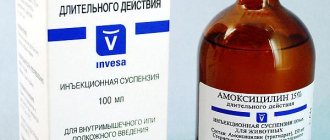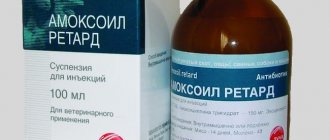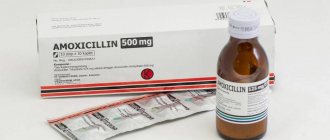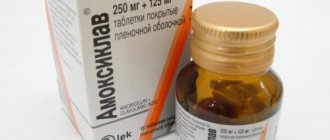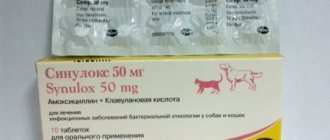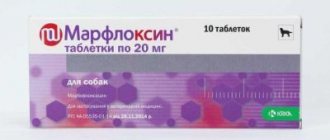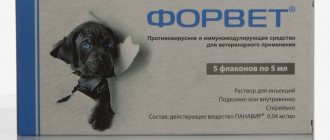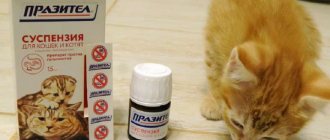What is amoxicillin?
Amoxicillin is a broad-spectrum antibiotic used to treat a variety of dog infections caused by susceptible strains of bacteria.
Amoxicillin is sold as an injection, powder for oral suspension, capsules or tablet and requires a prescription from your veterinarian.
The drug AMOXICILLIN 15% (Amoxicillin 15%) contains 150 mg of amoxicillin in the form of trihydrate and an oily filler as an active ingredient in 1 ml. Bottles of 10 ml and 100 ml.
Its pharmacological action
The principle of action of Amoxicillin is that when it enters the body, it stops the production of substances necessary for the functioning of bacteria and infections. As a result, they stop reproducing, and later die completely due to the destruction of the cell structure. Since the active substance is distributed throughout the body, it kills all bacteria, regardless of their current location.
The fastest way to cope with this task is Amoxicillin for dogs by injection. Literally 120 minutes after the substance is introduced into the pet’s body, its effect begins. When its effect wears off, it will be excreted in urine and bile.
DOSAGE AND APPLICATION FOR DOGS
According to the instructions for use, amoxicillin is a prescription drug available in the form of tablets of 100 and 400 mg, capsules of 250 and 500 mg, and amoxicillin suspension for oral use.
The usual dose of amoxicillin for dogs is 10-20 mg/kg every 12-24 hours. Contact your veterinarian immediately if your pet develops severe or bloody diarrhea. Amoxicillin 15% is administered to dogs intramuscularly or subcutaneously at a dose of 1 ml per 10 kg of animal weight (15 mg / 1 kg of body weight).
The contents of the bottle are thoroughly shaken. If necessary, the drug can be re-administered after 48 hours.
The principle of action of the drug
The antibacterial agent Amoxicillin works effectively against many types of bacteria: Escherichia coli, streptococci, staphylococci, Haemophilus influenzae and others.
Amoxicillin can destroy E. coli, which is a source of diseases of the gastrointestinal tract and urinary system
There are different types of pathogens: bacteria, viruses, pathogenic fungi. Antibiotics are only harmful to bacteria. Medicines are not able to “neutralize” other pathogens.
Amoxicillin belongs to the group of penicillins, which predominantly work according to the same principle. All bacteria have a “thoughtful” structure that ensures their survival in various conditions. On top, microorganisms are covered with peptidoglycan, a durable shell. Penicillins, penetrating the body, destroy the protective “shell” of bacteria. This leads to catastrophic consequences for pathogenic microbes: they die.
Penicillins were discovered at the beginning of the last century by British bacteriologist Alexander Fleming.
Amoxicillin is quickly absorbed from the injection site and distributed hematogenously (through the bloodstream) throughout the cat's body. The peak effect of the drug is observed 1–2 hours after administration of the drug; the duration of exposure is 48 hours. The drug is excreted primarily through the urinary tract.
What are the potential side effects of amoxicillin for dogs?
Contact your veterinarian immediately if your pet experiences severe or bloody diarrhea during treatment. Stop giving amoxicillin and seek emergency veterinary care if an allergic reaction (shortness of breath; hives; swelling of the lips, tongue, or face; rash or fainting), seizure, unusual bleeding or bruising occurs. Other less serious side effects, such as mild nausea, vomiting, diarrhea or abdominal pain, yeast or fungal infection, may be more likely. Continue giving amoxicillin and bring your pet to the vet if these illness symptoms occur again. Talk to your veterinarian about any side effect that seems unusual or unpleasant to your pet.
Contraindications and possible side effects
A general contraindication that is indicated in all instructions for drugs with the trade name Amoxicillin is the cat’s individual intolerance to penicillin antibiotics.
In the instructions for the drugs, Kergo BV, NITA-PHARM LLC, in the “contraindications” paragraph, it is also stated that the drug is not used for severe pathologies of the liver and kidneys.
Side effects from the drug are very rare. The most common side effect is the formation of edema at the injection site. This complication does not require treatment and goes away on its own within 1–2 days.
In case of a drug overdose, a cat may experience the following signs:
- impaired coordination of movements;
- symptoms of intoxication: nausea, vomiting, loose stools;
- lack of appetite.
Pregnancy in cats is not a contraindication for the use of the drug.
What other drugs will affect amoxicillin?
Before giving amoxicillin, tell your veterinarian if your pet is being given another antibiotic.
(for the same or a different infection), allopurinol or probenecid.
You may not be able to give amoxicillin, or your dosage may need to be adjusted. Other drugs besides those listed may also interact with amoxicillin. Talk to your veterinarian or pharmacist before giving any prescription or over-the-counter medications, including vitamins, minerals, and herbal products. ^Top
Release form
Amoxicillin can be purchased in the form of a suspension for intramuscular and subcutaneous administration, tablets and powder for oral administration.
- The injection liquid is poured into small dark glass bottles. It includes not only the active ingredient, but also a special oil filler that activates the medicinal components. The convenient dosage of Amoxicillin for dogs in injections makes this form of release the most profitable.
- Tablets contain approximately 0.25-0.5 milligrams of active ingredient. They are not destroyed due to the influence of gastric juice and are quickly absorbed through the walls of the stomach directly into the blood.
- The powder contains 150 milligrams of Amoxicillin per gram. It is packaged in bags, the weight of each of which varies from a gram to a kilogram.
But veterinarians do not recommend either tablets or powder; they have to be given to pets by force.
Amoxicillin
Produced in bottles of 100 ml of suspension. 1 ml of oily suspension for injection contains 150 mg of amoxicillin in the form of trihydrate.
Amoxicillin is a semi-synthetic broad-spectrum penicillin that has bactericidal activity against most gram-positive and gram-negative bacteria, including: Escherichia coli, Klebsiella, Pastarella, streptococci, staphylococci, etc. After parenteral administration, it quickly penetrates into body tissues and fluids, as a result of which the concentration of the drug in tissues exceeds the concentration of other antibiotics from its group. Most amoxicillin is excreted unchanged in the urine.
Used in the treatment of infections of the respiratory tract, digestive tract, genitourinary system, skin and soft tissues caused by bacteria sensitive to amoxicillin.
The drug is contraindicated in case of hypersensitivity of pets to penicillin antibiotics. Administered intramuscularly to dogs and cats at a dose of 7 mg/kg once a day.
A large number of commercial drugs containing amoxicillin as an active ingredient are produced abroad. Some of them come to our country.
A dosage form of amoxicillin is produced in Slovenia under the name “Aminoxyclav” - tablets containing 200 mg of the antibiotic and 50 mg of clavulanic acid. The latter protects amoxicillin from destruction by beta-lactamases. Prescribed orally to dogs and cats at a dose of 12.5 mg/kg 2 times a day.
The French company supplies the drug “Vetrimoxin” to our country in the form of dosage forms - paste, tablets, solution. The paste contains 300 mg of amoxicillin (in trihydrate form), 150 mg tablets, and the injection solution contains 15 g of antibiotic per 100 ml. The doses of each amoxicillin formulation are 1 mg/kg, 1 ml/10 kg (15 mg/kg), respectively. Amoxicillin 15% comes from Spain in the form of an injection suspension containing 150 mg of amoxicillin trihydrate per ml. Available in bottles of 10, 50 and 100 ml. Administered intramuscularly and subcutaneously to dogs and cats at a dose of 2 ml/10 kg body weight.
Foreign drugs with similar compositions are registered under the commercial names “Amoxy-kel” (Poland), “Amuril” (Slovenia), “Clamoxil” (Belgium). The latter drug deserves special attention, since it is very often used for the treatment and prevention of infectious diseases of various localizations in dogs and cats. Recently, a new universal form of the drug has been developed - “Clamoxil LA”. It is an injectable form of the active substance with a prolonged action. The concentration of amoxicillin is maintained in the biological media of the body at a therapeutic level for 48 hours. The drug is injected subcutaneously or intramuscularly into dogs and cats at the rate of 1 ml per 10 kg of body weight.
Amoxicillin is an antibiotic of the penicillin group.
What to do if your pet becomes ill after taking the medicine?
Side effects and the use of Amoxicillin in parallel with another medicine can lead to a deplorable condition for the dog. The most common version of events is a toxic reaction. It is signaled by severe vomiting, nausea and diarrhea, refusal to eat and drink. In case of poisoning with the drug, you must urgently take the animal to a veterinary clinic. Less commonly, liver damage, blood flow and kidney function disorders occur. In any case, medical attention is needed.
The drug is not that expensive, so if your pet cannot tolerate it, you can simply refuse treatment. Standard prices for Amoxicillin in regional pharmacies and without discounts are as follows.
| Release form | Price, rub |
| 20 tablets. | From 100. |
| 10 milliliters for injections. | 200-260. |
| 100 milliliters for injection. | 600-800 |
| 1 pack of powder | From 70. |
Unfortunately, it is difficult to find the powder form of the drug; many breeders resort to ordering on the Internet.
Video: how to properly give an injection to a dog?
Instructions for use of Amoxicillin for dogs
There are instructions for each of the three types of antibiotics: for tablets, for injections and for powder, respectively. Each release form has its own application nuances. For example, after an injection of Amoxicillin, a dog may limp, and even refuse the powder dissolved in the drink. To avoid all these troubles, it is important to correctly calculate the dosage and choose the most convenient variation of the drug.
How and where should the medicine be injected?
Due to the high effectiveness of the drug, one-time injections are prescribed. If the disease is advanced, a second injection is possible after two days. But such a decision is made only by a specialist. The required amount of medicine for the initial injection is calculated based on the proportion of milliliter per 10 kilograms. The breed and age of the pet in this case does not matter at all, and neither does the disease: both for rhinitis and cystitis in dogs, the maximum dose is the same.
The drug is injected into the muscle under the leg or into the fold of the neck if the subcutaneous method of administering Amoxicillin was chosen. Before use, the disposable syringe with suspension should be shaken well: it should be homogeneous. As soon as the course of injections is completed, it is necessary to ensure that the dog’s microflora is restored and protected from dysbacteriosis. To do this, she is prescribed products with a high concentration of lactobacilli and bifidobacteria. The procedure is as follows:
- Hands are treated with alcohol or thoroughly washed with water.
- The bottle of Amoxicillin is shaken until the sediment inside is completely dissolved.
- It breaks, and the broken area is treated with a disinfectant wipe.
- The contents of the suspension ampoule are carefully drawn into a disposable sterile syringe.
- The syringe rises up, all excess air is released from it.
- The site chosen for the injection is treated with alcohol-based cotton wool, the needle is carefully inserted into it, and when pressing on the syringe, its contents are injected into the muscles or under the skin of the pet.
How to give tablets and powder correctly?
The use of tablets in the treatment of Amoxicillin involves systemic treatment. The daily dose of the drug is 12.5 milligrams per kilogram of live weight. Ideally, you need to split the daily dose into two doses in the morning and in the evening. Treating your pet for more than one week is strictly prohibited, as is giving your dog human Amoxicillin. The exact number of days to take the tablets should be determined after consultation with your veterinarian.
The powder is dissolved in drinking water. The exact dose is calculated according to the following scheme: two grams of the product should account for 10 kilograms of the pet’s body weight. In this case, the duration of treatment should not exceed three or five days, depending on the severity of the disease and the general condition of the animal. This is due to the fact that in the powder the active substance is in a concentrated state. The powder should be given no more than once a day.
Reviews
The antibiotic Amoxicillin 150 is an excellent medicine; we injected it into the cat after sterilization. It was very convenient for us that it could be injected once every 2 days, since our cat does not like to be treated and does not give injections well. The postoperative period passed without complications for us!
Irina, owner of a Siamese cat
We used an antibiotic for a dog with severe diarrhea due to an intestinal infection, and it helped us recover very quickly.
Vladimir, owner of a Russian spaniel
I repeatedly use Amoxicillin as prescribed by a veterinarian to treat various diseases. The convenient thing is that you can buy it in large quantities, and it is suitable for different animals. Since I have a lot of cows, goats and pigs, I always keep it in reserve.
Nikolai, farmer
Amoxicillin is an inexpensive, accessible drug that is sold in almost any pharmacy in our city. Last year our shepherd got into a fight with another dog and the wounds festered. After two injections everything went away and dragged on.
Anastasia, owner of an East European Shepherd
Purpose
The scope of use of antibacterial drugs in veterinary medicine is wide. Amoxicillin is used to treat the following conditions in dogs:
- gastroenteritis;
- enteritis;
- gastroenterocolitis and other intestinal infections;
- parainfluenza;
- pathologies of the respiratory system - rhinitis, bronchitis, pneumonia and other respiratory diseases;
- urinary system infections – cystitis, pyelonephritis;
- endometritis;
- mastitis;
- arthritis and other joint inflammations, etc.
Taking antibiotics is necessary in the treatment of inflammatory processes in soft tissues and skin. Amoxicillin is prescribed after surgery to prevent complications, for large wounds, to avoid infection.
special instructions
Slaughter of animals for meat is permitted 14 days after cessation of drug administration. The meat of animals forcedly killed before the expiration of the specified period can be used to feed fur-bearing animals or to produce meat and bone meal. Milk from animals that have been administered a 15% amoxicillin suspension can be used for food purposes 48 hours after the end of treatment. Milk obtained from animals during the period of amoxicillin use and until 48 hours after the last administration of the drug is used for feeding animals.
Purpose, indications for use
Amoxicillin 15% is used in veterinary medicine:
- for the treatment of large and small cattle, pigs, dogs and cats with infectious diseases of the respiratory tract (rhinitis, pneumonia, bronchopneumonia), gastrointestinal tract (diarrhea, enteritis, colibacillosis, salmonellosis) and genitourinary system (cystitis, endometritis, metritis, vaginitis, leptospirosis), mastitis, lesions of the skin, soft tissues and hooves (necrobacteriosis, arthritis, abscess);
- as well as for the prevention of surgical postoperative infections caused by microorganisms sensitive to amoxicillin.
Pharmacological properties
Amoxicillin veterinary is a semi-synthetic antibiotic of the penicillin group. Works well on gram-positives, such as Actinomyces spp., Bacillus anthracis, Clostridium spp., Corynebacterium spp., Erysipelothrix rhusiopathiae, Listeria monocytogenes, Staphylococcus spp., Streptococcus spp. and gram-negative microorganisms - Actinobacillus spp., Bordetella onchiseptica, E. coli, Salmonella spp., Fusobacterium spp., Haemophilus spp., Moraxella spp., Pasteurella spp., Proteus mirabilis. This drug has no effect on strains of penicillin-forming microorganisms - Klebsiella, Enterobacter and Pseudomonas. Amoxicillin veterinary, by preventing the synthesis of the bacterial cell wall, inhibits the enzymes transpeptidase and carboxypeptidase and disrupts the osmotic balance. These processes lead to the fact that bacteria die during growth. The oily filler, which is part of the medicine, gradually releases micronized amoxicillin into the blood, which ensures the duration of action of the antibiotic. If the drug is used parenterally, in this case it is well absorbed and disperses well throughout the body. Due to the fact that the connection with plasma proteins is 17-20%, which is insignificant, the highest concentration is achieved in muscle tissue, liver, kidneys, and gastrointestinal tract. Amoxicillin passes slightly into the brain and bone fluid. The exception is when the meninges are inflamed. In blood plasma, the concentration becomes maximum one to two hours after the drug is administered and remains at the required level for about two days. Metabolization of amoxicillin practically does not occur; it is excreted in urine, milk and bile.
